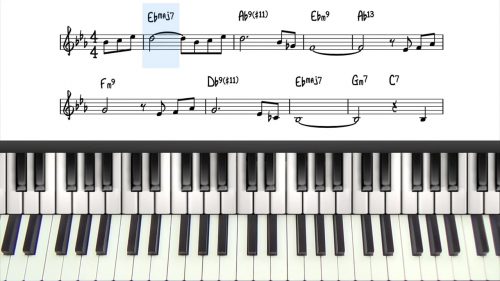1625 Progression Drills & Exercises
Welcome to this tutorial on the 1625 turnaround.
The 1526 turnaround is found throughout jazz music. We’re going to introduce an exercise that will not only get the changes in our hands, but make the notes clearer in our mind.
Start With Triads
To start this exercise we are not going to have any dominant variations on the vi or ii , so it will be the straight up I major to the vi minor, ii minor, and V dominant.
Move Onto 7th Chords
We can stay with the triads as long as you like, out of tempo, taking your time to think through if needed and once it’s clear we can try to keep a steady rhythm, slow at first, then faster.
Once we are comfortable here, we can do this same exercise but with 7th Chords, which is really the same but adding in one more note to our right hand.
The Benefits Of This Exercise
By working on these exercises, we are laying the foundation to sight read and learn new tunes quickly. The minute we identify this turn around on a chart… we are in familiar territory!
You’ll also have an easier time with more complicated voicings on these very changes, and finally, you’ll be on your way to be a master transposer as your brain will be more skilled in flipping between keys.
Any comments or questions, please post below.
Lesson Downloads
-
1625 Lesson Notation File Type: pdf
Practice Tips
-
You'll find your mind can move quickly between the keys, so you've created more flexibility in your mental processes, whilst gaining valuable muscle memory in your hands.
-
The next step is to bring inversions and interesting inner voice leading.
-
You can also practice walking bass patterns and/or melodic phrases in the right hand.
- Using the same pattern through all 12 keys helps us to get better at transposition.






Hi Lyndol, this is a great lesson and exercise. I was wondering if you had any suggestions about how to extend this material. I find that inversions of chords are always a challenge, as my brain can’t get there fast enough, and I seem to stay stuck in root position. If you have advice about inner voice leading that would be useful too.
Many thanks, Natasha
Hi Natasha 👋
Here’s a few recommendations for you.
To extend this material I’d recommend first playing the following progression:
Imaj9 / VI7b9 / ii-9 / V13
Check out chapter 2 of this lesson: https://www.pianogroove.com/jazz-piano-lessons/1625-436251-progressions/
In a 1625 progression, the VI7 chord is often playing with the b9 alteration, however, we can add any combination of extensions and alterations. It’s nice to experiment with upper structure triads on the 2 dominant chords in the progression. Perhaps take the Upper Structure Cheat Sheet and play around with the 4 most common upper structures over the VI7 chord, and the V7 chord.
For inner voice movement, you can apply the concepts and principles that I cover in this lesson on inner voices: https://www.pianogroove.com/jazz-piano-lessons/adding-inner-voice-movement/
Enjoy playing around with this stuff, it’s fun exploring harmony in this way!
Cheers, Hayden
Thanks Hayden, have started working through this. All the information is such a revelation, and there is so much to learn.
Cheers, Natasha
This is SUPER COOL! Would love to try this too! Yay! 🙂 Thanks so much for this lesson!